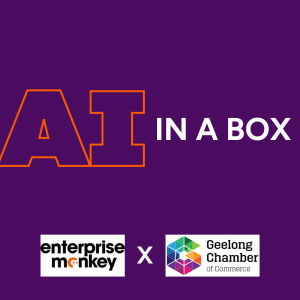Generative AI for Marketers: Finally De-Mystified for Real-World Use
Generative AI for Marketers: Finally De-Mystified for Real-World Use
Your competitor just launched a campaign that would’ve taken your team three weeks to produce — and they did it in three days. Sound familiar? Welcome to the new reality of marketing, where generative AI isn’t just another buzzword but the difference between leading the market and playing catch-up.
I’ve spent the last few years watching marketing teams across Australia and the US wrestle with AI adoption. Some nail it. Most don’t. The difference? It’s not about being tech-savvy or having massive budgets. It’s about understanding what generative AI actually does and knowing exactly how to use it for marketing — without the fluff, without the jargon, and definitely without needing a computer science degree.
Here’s what I know: 65% of organisations are now using generative AI regularly, nearly double from just 10 months ago. Yet 91% of professionals still demand AI outputs be 100% accurate before they’ll use them without human review. That gap between adoption and trust? That’s where the opportunity lives.
This guide isn’t about convincing you AI is the future. You already know that. It’s about showing you exactly how to use generative AI tools, write prompts that actually work, and integrate AI into your marketing workflow — starting tomorrow morning.
The AI Buzz, Finally Explained (Without the Jargon)
Let’s cut through the noise. Generative AI is simply technology that creates new content — text, images, videos, code — based on patterns it’s learned from existing data. Think of it as having a brilliant intern who’s read every marketing book, studied every successful campaign, and can draft content in seconds. Except this intern never sleeps, never complains, and scales infinitely.
But here’s where it gets interesting for marketers specifically. Unlike traditional AI that might analyse your customer data or predict trends, generative AI actively creates. It writes your email sequences. It drafts your social posts. It generates campaign ideas. It even helps you understand your audience better by synthesising research in ways that would take humans weeks.
The stats tell the story: organisations using generative AI jumped from 33% in 2023 to over 65% in 2024. That’s not gradual adoption — that’s a stampede. And it’s happening because early adopters are seeing real results. We’re talking about marketing teams producing content 5x faster, personalising campaigns at scale, and finally having time to focus on strategy instead of execution.
But let’s address the elephant in the room — the pain points keeping many marketers on the sidelines:
Skills gaps remain the biggest barrier. Half of all businesses cite lack of skilled professionals as their main adoption challenge. Fair enough. Most marketing degrees didn’t include “AI prompt engineering” in the curriculum. But here’s the thing: you don’t need to be technical. You need to be strategic. The best AI users I know are marketers who understand their audience, not programmers who understand algorithms.
Accuracy concerns are real but misunderstood. Yes, 91% of professionals want AI outputs to be perfect before using them. But that’s like expecting your junior copywriter to nail every brief on the first draft. AI isn’t meant to replace human judgment — it’s meant to give you a massive head start. Think 80% done in 20% of the time, not 100% done with zero input.
Leadership hesitation is holding teams back. 43% of companies struggle with lack of vision among leaders. I see this constantly — CEOs who’ve heard horror stories about AI hallucinations or brand disasters, so they pump the brakes. Meanwhile, their competitors are learning, iterating, and pulling ahead. The risk of standing still now outweighs the risk of moving forward carefully.
Here in Australia, we’re seeing interesting patterns. While 75% of CMOs are taking a “wait and watch” approach due to risk concerns, forward-thinking organisations like PwC Australia have already committed $12 million to AI centres of excellence, creating 30 new AI-specific roles. The gap between the cautious and the committed is widening daily.
Where Gen AI Delivers the Most Value in Marketing
Let me be clear: AI won’t replace marketers. But marketers using AI will absolutely replace those who don’t. The question isn’t whether to use it, but where to start. After working with dozens of teams, I’ve identified the sweet spots where generative AI delivers immediate, measurable value.
Content creation at scale. This is the obvious one, but it goes deeper than “ChatGPT writes blogs.” I’m talking about creating 50 localised versions of your campaign for different markets. Generating A/B test variations for every email. Producing social content that maintains your brand voice across platforms. A Melbourne construction firm I advised went from producing one blog post monthly to publishing twice weekly — same team, same budget, just smarter use of AI for first drafts and ideation.
Audience intelligence and segmentation. Feed your customer data into Claude or Gemini and ask it to identify patterns humans miss. One retail client discovered three distinct customer personas they’d never identified in five years of manual analysis. The AI spotted purchase pattern correlations that led to a 23% increase in email engagement through better segmentation.
Campaign analysis and reporting. Remember spending days creating campaign reports? AI can analyse performance data, identify trends, and draft executive summaries in minutes. But here’s the key: it’s not just about speed. AI spots connections between campaigns, channels, and outcomes that help you understand why something worked, not just that it worked.
Let me share how we think about this at Enterprise Monkey. We use what I call the “80/20 AI rule” — AI gets you 80% of the way there in 20% of the time. That remaining 20%? That’s where human creativity, strategy, and brand understanding come in. It’s not about AI doing everything; it’s about AI doing the heavy lifting so you can focus on what matters.
Three practical workflows where AI already saves time and improves consistency:
1. The Campaign Launch Workflow: Brief to AI → Generate campaign concepts → Human selects best ideas → AI creates variations for different channels → Human refines and approves → AI helps with scheduling and distribution. What used to take two weeks now takes two days.
2. The Content Calendar Workflow: Trending topics analysis via AI → Content idea generation → AI drafts posts → Human adds brand personality → AI suggests optimal posting times → Performance analysis feeds back into the system. One person can now manage what used to require a team of three.
3. The Customer Response Workflow: Customer inquiry comes in → AI categorises and suggests response → Human reviews and personalises → AI helps track resolution → Patterns feed into FAQ and content creation. Response times drop from hours to minutes while maintaining quality.
Australian businesses are seeing particular success with personalisation (95% using AI for this), but here’s the catch — only 19% are fully utilising their marketing technology stack due to data gaps. That’s like having a Ferrari but only driving in second gear. The opportunity isn’t just in adopting AI; it’s in connecting it properly to your existing systems.
Must-Have Gen AI Tools & Assistants for Non-Tech Marketers
Right, let’s talk tools. But first, a reality check: you don’t need every AI tool on the market. You need the right ones for your specific needs, and you need to actually learn how to use them properly. I see too many marketers collecting AI subscriptions like Pokemon cards, then wondering why they’re not seeing results.
Here’s my recommended toolkit for non-technical marketers, mapped to what you actually need to do:
For content creation: ChatGPT remains the Swiss Army knife. It’s versatile, constantly improving, and most marketers already have some familiarity with it. Use it for blog posts, email copy, social media content, and brainstorming. Pro tip: pay for GPT-4. The quality difference is worth every cent.
For long-form content and analysis: Claude is your secret weapon. It handles larger documents better than ChatGPT and excels at maintaining consistency across long pieces. Perfect for whitepapers, comprehensive guides, and analysing lengthy research documents. I use Claude when I need to synthesise multiple sources or maintain a specific tone across 5,000+ words.
For research and fact-checking: Perplexity AI. Think of it as Google meets ChatGPT. It searches the web and synthesises information with citations. Brilliant for market research, competitor analysis, and ensuring your content is current and accurate.
For data analysis and insights: Gemini (Google’s offering). Particularly strong at understanding and analysing data from Google’s ecosystem. If you’re using Google Analytics, Ads, or Sheets, Gemini integrates beautifully and can surface insights you’d miss manually.
For visual content: Midjourney or DALL-E 3. Yes, even non-designers can create compelling visuals. But here’s the key — use these for concept development and placeholder images, not finished brand assets. They’re idea accelerators, not designer replacements.
For analytics and reporting: Domo, Looker, or Pecan AI. These platforms use AI to turn your marketing data into actionable insights. They’re particularly valuable for predictive analytics — understanding not just what happened, but what’s likely to happen next.
Now, let’s map these to actual job roles and use cases:
Content Marketer: ChatGPT for daily content, Claude for long-form pieces, Perplexity for research. Start your day by asking ChatGPT to summarise industry news relevant to your audience. Use Claude to turn your bullet points into comprehensive guides. Let Perplexity fact-check and find supporting data.
Social Media Manager: ChatGPT for post creation, DALL-E for quick visuals, Gemini for hashtag research and trend analysis. Create a week’s worth of posts in an hour, then spend your saved time actually engaging with your community.
Email Marketing Specialist: ChatGPT for subject lines and copy variations, Claude for newsletter content, Pecan AI for predictive analytics on send times and segmentation. Test 10 subject lines instead of two. Personalise content for segments you didn’t even know existed.
Marketing Manager: Domo or Looker for dashboard creation, Gemini for competitive analysis, ChatGPT for report writing. Spend less time gathering data and more time developing strategy based on AI-surfaced insights.
Easy onboarding is crucial. Here’s how successful teams are integrating these tools:
Start with one tool, master it, then expand. I recommend beginning with ChatGPT because it’s the most versatile and has the gentlest learning curve. Dedicate 30 minutes daily for your first week just playing with it. Try rewriting existing content, brainstorming campaign ideas, or analysing competitor websites.
Create prompt libraries for common tasks. When you find a prompt that works well, save it. Build a shared document where your team can access proven prompts for different scenarios. This becomes your playbook and dramatically reduces the learning curve for new team members.
Set up workflows, not just tools. The magic happens when you connect these tools to your existing processes. For example: research with Perplexity → outline with ChatGPT → write with Claude → analyse performance with Domo. Each tool has its strength; use them in combination.
Here’s an interesting stat: 62% of Australian businesses increased their AI marketing spend in 2024, but data integration remains the biggest bottleneck. They have the tools but struggle to connect them to their CRM, analytics platforms, and content management systems. Don’t make this mistake. Before adding new tools, ensure they play nicely with your existing stack.
Exactly What to Say: High-Impact Prompt Templates That Work
Here’s the truth nobody tells you: the difference between mediocre AI output and brilliant AI output isn’t the tool — it’s the prompt. I’ve seen marketers give up on AI because they got rubbish results, not realising they were essentially giving rubbish instructions.
Think of prompting like briefing a new team member. Would you tell them “write something about our product” and expect gold? Of course not. Yet that’s exactly how most people prompt AI. Let’s fix that.
The anatomy of a powerful prompt has four elements:
Context: Who you are, what you’re doing, and why. “I’m a marketing manager for a sustainable fashion brand in Melbourne targeting eco-conscious millennials.”
Task: Exactly what you want created. “Write three Facebook ad variations for our new bamboo t-shirt line.”
Format: How you want it structured. “Each ad should have a headline (max 40 characters), body text (max 125 characters), and a call-to-action.”
Tone: The voice and style you need. “Use a conversational, slightly cheeky Australian tone that emphasises sustainability without preaching.”
Let me show you the difference this makes. Here’s a weak prompt versus a strong one:
Weak: “Write social media content about our sale.”
Strong: “You’re a social media manager for an Australian outdoor gear retailer. Create 5 Instagram posts announcing our end-of-summer sale (30% off all camping equipment). Each post should include: 1) An attention-grabbing first line, 2) 2-3 sentences highlighting specific products or benefits, 3) A clear CTA, 4) 3-5 relevant hashtags. Use an enthusiastic but authentic tone that appeals to weekend warriors and family campers. Include one post specifically about sustainability/eco-friendly products.”
The difference in output quality is staggering. The first might give you generic “SALE NOW ON!” content. The second delivers ready-to-post content tailored to your brand and audience.
Here are proven templates for common marketing tasks:
For email subject lines:
“Generate 10 email subject lines for [specific campaign/product]. Our audience is [demographic]. The email content is about [key message]. Aim for: 5 curiosity-driven, 3 benefit-focused, 2 urgency-based. Each under 50 characters. Avoid spam triggers like ‘free’ or excessive punctuation.”
For landing page copy:
“Write landing page copy for
For blog post outlines:
“Create a detailed outline for a 1,500-word blog post about [topic]. Target reader: [description]. Their main challenge: [problem]. Goal of the post: [desired outcome]. Include: engaging intro hook, 4-5 main sections with subpoints, practical examples for each section, conclusion with clear takeaway. Suggest 2-3 internal links opportunities.”
For social media campaigns:
“Develop a 5-day social media campaign for
But here’s where it gets really powerful — iteration. Your first prompt is just the beginning. Use follow-ups like:
- “Make the tone more conversational”
- “Add more specific examples”
- “Shorten by 30% while keeping key points”
- “Rewrite for a B2B audience instead”
- “Include statistics to support the main points”
I’ve created what I call the “Dumb Monkey Prompt Pack” — a collection of tested, Australian-market-proven prompts that consistently deliver results. These aren’t theoretical; they’re pulled from real campaigns that moved the needle. The pack includes templates for everything from TikTok scripts to executive email sequences, all structured to get you 80% of the way to publishable content on the first try.
Remember: AI doesn’t read your mind. It reads your prompts. The clearer and more specific you are, the better your results. Spend time crafting your prompts — it’s the highest-leverage skill in AI marketing.
Success Stories & Slip-Ups: What Aussie Biz Leaders Are Learning Fast
Let’s get real about what’s actually happening in Australian businesses with AI. Not the glossy case studies from tech giants, but the messy, instructive reality of companies figuring this out in real-time.
PwC Australia’s $12 Million Bet
In August 2024, PwC Australia didn’t just dip their toes into AI — they cannonballed in with a $12 million AI Centre of Excellence and 30 new AI-specific roles. But here’s what the press release didn’t tell you: the first three months were chaos.
They discovered that having AI tools and knowing how to use them are vastly different things. Initial attempts at AI-generated client reports were technically accurate but lacked the nuanced understanding that builds trust. The breakthrough came when they stopped trying to replace human insight and started using AI to enhance it. Now, their consultants use AI to analyse vast amounts of client data and surface patterns, but humans craft the strategic recommendations.
The result? Report creation time dropped by 60%, but more importantly, consultants now spend most of their time on high-value strategic thinking rather than data crunching. One senior manager told me, “AI didn’t replace any jobs — it replaced the worst parts of everyone’s job.”
Google & Bastion’s Publishing Experiment
Google and Bastion Digital’s 16-week pilot with 12 Australian publishers offers fascinating lessons. They provided access to Gemini, Pinpoint, and AI Studio, expecting publishers to focus on content creation. Instead, the biggest wins came from unexpected places.
One publisher used AI to analyse five years of article performance data and discovered their most engaged readers weren’t who they thought. They’d been creating content for urban professionals when their actual superusers were regional small business owners. AI spotted patterns in reading times, device usage, and content shares that humans had missed.
Another publisher automated their newsletter curation process. What took an editor three hours daily now takes 30 minutes of AI-assisted curation and human refinement. But here’s the key: they didn’t fire the editor. They redirected those saved hours into reader community building, which drove subscription revenue up 15%.
The failures were equally instructive. Three publishers tried using AI to write entire articles without human oversight. Reader engagement plummeted. Turns out, AI can nail the facts but misses the subtle local context and voice that builds audience connection. The lesson? AI amplifies human capability; it doesn’t replace human judgment.
Common Mistakes I See Every Week
Over-reliance without understanding. A Brisbane retailer went all-in on AI-generated product descriptions. Sales dropped 20%. Why? The AI descriptions were technically perfect but missed the emotional triggers their customers responded to. They’d optimised for search engines, not humans. Now they use AI for first drafts, but humans add the soul.
Ignoring brand voice. A Melbourne startup used ChatGPT for all their social media. Within weeks, they sounded like every other company using ChatGPT. Their distinctive voice — what made them special — vanished. The fix? They created a comprehensive brand voice guide and trained their AI prompts to follow it. Now their content is efficient AND authentic.
Skipping human oversight. A financial services firm published an AI-generated blog post about investment strategies. It contained outdated regulatory information that could have led to serious compliance issues. Lucky they caught it before major damage, but it reinforced a critical rule: AI outputs need human verification, especially in regulated industries.
Here’s what I tell every client: AI is like having a brilliant intern who’s read everything but experienced nothing. They can research, draft, and analyse brilliantly, but they need your wisdom, context, and judgment to create something truly valuable.
The most successful AI adopters share three characteristics:
They start small and scale based on success. Instead of revolutionising everything at once, they pick one process, perfect it, then expand. A Sydney agency started with email subject lines. Once they mastered that, they moved to email body copy, then blog posts, then campaign strategies. Gradual expansion built confidence and competence.
They maintain human oversight at critical points. AI does the heavy lifting, but humans make the final calls. Think of it as AI doing the research and first draft, humans adding strategy and polish. This hybrid approach delivers the best of both worlds — AI efficiency with human insight.
They measure relentlessly. Not just vanity metrics, but real business impact. Time saved, engagement increased, revenue generated. One client tracks “AI-assisted revenue” — sales from campaigns where AI played a significant role. It’s now 40% of their total and growing.
The Australian market is teaching us something important: success with AI isn’t about being first or fastest. It’s about being thoughtful, strategic, and maintaining the human elements that make your brand special. The companies winning with AI aren’t replacing their people — they’re amplifying what makes their people brilliant.
What to Do Next — Your Safe, Smart Start into AI Marketing
Right, you’ve made it this far. You understand what generative AI can do, you’ve seen the tools, you know how to write prompts, and you’ve learned from others’ successes and stuff-ups. Now what? Let me give you a practical roadmap that won’t overwhelm your team or break your budget.
Your AI Adoption Checklist
Before you sign up for any tool, answer these questions:
What’s your biggest marketing time sink right now? Don’t try to fix everything. Pick one process that eats hours but doesn’t require deep strategic thinking. Common winners: email writing, social media content, report generation, or research synthesis.
What’s your team’s tech comfort level? Be honest. If your team struggles with basic marketing automation, don’t start with complex AI workflows. Begin with user-friendly tools like ChatGPT before moving to specialised platforms.
What’s your risk tolerance? If you’re in healthcare, finance, or law, you need stricter oversight processes. If you’re in e-commerce or hospitality, you can experiment more freely. Match your AI approach to your industry’s requirements.
What’s your budget reality? Good news: you can start with free versions of most tools. Bad news: free versions have limitations that might frustrate power users. Budget $50-200/month initially for paid versions of 1-2 core tools.
What does success look like? Define this upfront. Is it publishing more content? Higher engagement rates? Time saved? Revenue increased? Without clear success metrics, you’ll never know if AI is actually helping.
Integration Without Disruption
The biggest mistake I see is companies trying to revolutionise everything overnight. Here’s how to integrate AI without breaking what already works:
Week 1-2: Exploration phase. Give your team dedicated time to play with AI tools. No pressure to produce anything. Just learn. I recommend 30 minutes daily where people can experiment without judgment. Share discoveries in a Slack channel or weekly meeting.
Week 3-4: Pilot project. Choose one small, low-risk project. Maybe it’s next week’s social media content or a single email campaign. Use AI for first drafts, but maintain your normal review process. Track time saved and quality achieved.
Week 5-8: Systematic integration. Based on pilot results, create standard operating procedures. Document which tools to use when, proven prompts, and review requirements. This becomes your AI playbook.
Week 9-12: Scale and optimise. Expand to additional use cases. Start connecting tools (like using AI-generated content ideas to feed your content calendar). Begin tracking ROI seriously.
The key is maintaining parallel processes initially. Don’t abandon what works until AI proves itself in your specific context. Think evolution, not revolution.
Ethics & Safety: The Non-Negotiables
Let’s address the elephant in the room — AI safety and ethics. This isn’t just about avoiding disasters; it’s about building sustainable, trustworthy marketing practices.
Data privacy is paramount. Never input customer personal information into public AI tools. If you’re using customer data for personalisation, ensure you’re using enterprise versions with proper data protection. One leak could destroy years of trust building.
Transparency matters. If AI significantly contributed to content creation, consider disclosure. Not legally required (yet) in most cases, but transparency builds trust. A simple “AI-assisted” note can actually increase credibility by showing you’re innovative but honest.
Fact-check everything. AI can confidently state completely incorrect information. Verify statistics, check dates, confirm regulations. I use a “trust but verify” approach — AI drafts, humans fact-check, especially for anything that could impact customer decisions or compliance.
Maintain brand authenticity. Your brand voice took years to develop. Don’t let AI genericise it in weeks. Create detailed brand guidelines for AI use. Include example prompts that capture your voice. Review AI content through the lens of “would our audience know we wrote this?”
Quality control is essential. Establish clear review processes. Who checks AI content? What are they checking for? How do you handle revisions? Document this process and stick to it, even when deadlines loom.
Your 30-Day Quick Start Plan
Here’s exactly what to do over the next month:
Days 1-7: Tool selection and setup. Choose one primary tool (I recommend ChatGPT Plus for most teams). Get everyone accounts. Schedule a team lunch-and-learn to explore together.
Days 8-14: Prompt training. Use the templates from this guide. Have each team member create content for their specific area. Share what works. Build your prompt library.
Days 15-21: First real project. Pick something with a deadline 2-3 weeks out. Use AI for ideation and first drafts. Maintain normal review processes. Document time saved and challenges faced.
Days 22-30: Process documentation and scaling. Based on learnings, create your team’s AI guidelines. Plan the next three use cases to tackle. Set monthly review meetings to share learnings and optimise approaches.
Free Resources to Accelerate Your Journey
At Dumb Monkey AI Academy, we’ve built resources specifically for non-technical marketers. No jargon, no complexity, just practical tools you can use immediately. This includes weekly prompt templates tested in Australian markets, tool reviews from actual marketers (not tech enthusiasts), and case studies from businesses like yours.
The community aspect matters too. Learning AI in isolation is tough. Having peers to share discoveries, troubleshoot challenges, and celebrate wins accelerates everything. We’ve seen members go from AI-skeptical to AI-proficient in weeks, simply by learning alongside others on the same journey.
Remember, this isn’t about becoming a tech expert. It’s about using technology to become a better marketer. The fundamentals haven’t changed — understanding your audience, crafting compelling messages, building trust. AI just helps you do these things faster and at scale.
The marketers thriving with AI aren’t the most technical. They’re the most curious, strategic, and willing to experiment. They see AI as a powerful assistant, not a magic solution. They maintain high standards while embracing new efficiencies.
Start small. Stay human. Scale what works. That’s your path to AI marketing success.
The Bottom Line
Here’s what it all comes down to: generative AI for marketing professionals isn’t about replacing human creativity — it’s about amplifying it. Every successful implementation I’ve seen follows the same pattern: marketers who understand their craft using AI to do more of what matters and less of what doesn’t.
The tools will evolve. New platforms will emerge. Capabilities will expand. But the core principle remains constant: AI is a lever, not a replacement. The question isn’t whether you’ll use AI in your marketing — that ship has sailed. The question is whether you’ll use it well.
Start tomorrow. Pick one task. Write one prompt. Generate one piece of content. Then make it better with your human insight. That’s how every AI marketing success story begins — not with a massive transformation, but with one curious marketer wondering “what if?”
The gap between those thriving with AI and those struggling isn’t technical knowledge. It’s the willingness to begin. Your competitors are already moving. The tools are accessible. The knowledge is here.
What’s your first prompt going to be?







Responses